Structure And Properties Of Dental Materials
Question 1. Write a short note on the biological properties of dental materials.
Or
Write a short note on the importance of the biological properties of dental materials.
Answer:
They should be nontoxic:
Compounds like amalgams which are used in dental restoration contain mercury and mercury vapor which produce toxic effects
- They should be non-irritating:
- Some compounds (dental cement) are acidic in nature like silicate, which irritates the pulp.
- The eugenol causes irritation and a burning sensation which is used in the impression material.
- Phosphoric acid which is used in etching, can irritate the surrounding tissue.
- Unreacted monomer irritates the pulp.
Read And Learn More: Dental Materials Question And Answers
They should be noncarcinogenic:
Some compounds like nickel and beryllium sometimes result in the formation of benign or malignant tumors which further results in cancer.
- They should not produce allergic reactions:
- Alginate dust while mixed is inhaled causes hazards.
- Some dental materials contain nickel and some people are allergic to nickel.
- Some materials contain beryllium while mixing be inhaled and causes “Berylliosis”.
- They should be biologically inactive: All compounds used in dentistry should not produce any adverse effect.
- They should not produce any antigenicity
Question 2. Describe briefly about stress and strain.
Or
Write briefly on stress and strain.
Or
Write a short note on stress and strain.
Answer:
Stress: When a force acts on the body, tending to produce deformation, resistance is developed within the body to this external force. This internal resistance of the body to the external force is called “Stress”.
Stress = \(\frac{\text { Force }}{\text { Area }}=\frac{\mathrm{F}}{\mathrm{A}}\)
Types of Stresses:
- Tensile stress.
- Compressive stress.
- Shear stress.
- Tensile stress: Results in a body when it is subjected to two sets of forces that are directed away from each other in the same straight line. The load tends to stretch or elongate a body.
Tensile stress
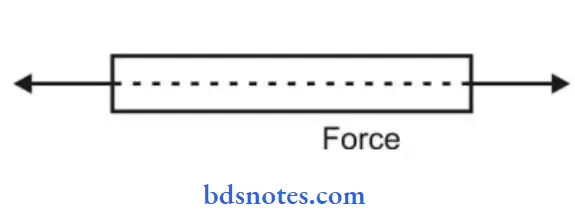
- Compressive stress: Results when a body is subjected to two sets of force in the same straight line but directed towards each other. The load tends to shorten a body.
Compressive stress

- Shear stress: Shear stress is a result of two forces directed parallel to each other, stress that tends to resist a twisting motion. Shear stress

Complex Stresses :
These may be a combination of tensile, compressive, and shear stresses. These multiple stresses are called complex stress, for example, When a wire is stretched the predominant stress is tensile, but shearing and compressive stresses will also be present because the wire is getting thinner as it elongates.
Strain Stresses:
If the stress (internal resistance) produced is not sufficient to withstand the external force (load) the body undergoes a change in shape
Each type of stress is capable of producing a corresponding deformation in the body.
The deformation resulting from tension is an elongation of a body, whereas compression causes shortening or compression of the body.
Strain = \(\frac{\text { Deformation/Change in length }}{\text { Original length }}=\frac{E}{L}\)
Question 3. Write a short note on malleability and ductility.
Or
Write a short note on ductility.
Or
Write briefly on malleability and ductility.
Or
Write a short note on ductility and malleability.
Answer:
Malleability: It is the ability of the material to withstand rupture under compression as in hammering or rolling into a sheet.
- It does not depend on strength.
- Malleability increases with the rise in temperature.
Ductility: It is the ability of a material to withstand permanent deformation under a tensile load without rupture. A metal that can be drawn readily into a wire is said to be ductile. Ductility depends on tensile strength.
Application of Malleability and Ductility:
- Gold is the most ductile and malleable metal. This property enables manufacturers to beat it into thin foil.
- Silver is a second ductile and malleable metal. Among other metals, platinum ranks third in ductility, and copper ranks third in malleability.
Significance of Ductility and Malleability:
- Ductility and malleability are important properties of metals, alloys, and a few plastics.
- The more the metal is ductile, the better its perishability.
- Metals with good ductility have good marginal adaptability and decrease marginal leakage.
- If a metal can be compressed or elongated, it has good ductility and malleability.
Question 4. Write a short note on annealing.
Answer:
The effect associated with cold working (for example, Strain, Hardening) can be reversed by simple heating of the metal. The process is called annealing. The more severe the cold working the more readily annealing occurs. Annealing is generally comprised of three stages which are as follows:
- Recovery: In the recovery stage, the properties of the cold worked metal begin to disappear before any significant changes are observed under microscopic examination.
- Recrystallization: When a severely cold worked metal is annealed recrystallization occurs after recovery. This involves a radial change in the microstructure.
- Grain growth: The average grain size of the recrystallized structure depends on the initial number of nuclei. The more severe the cold working, the greater the number of such nuclei, and the grain size for the recrystallized metal can range from fine to fairly coarse.
- This grain growth process is simply a bounded energy-minimizing process.
- The annealing is a relative process, the higher the melting point of the metal, the higher is the temperature needed for annealing.
Question 5. Write a short note on the hardness test.
Or
Describe briefly hardness.
Or
Write a short note on hardness.
Answer:
In mineralogy hardness to described as the ability of a material to resist scratching. In metallurgy and in most other fields, the resistance to indentations is called “hardness”.
In hardness tests, a small indenter is forced into the surface of the material to be tested under controlled conditions of load and rate of application. The depth or size of the indentation formed is measured. From this measurement, a hardness number is determined. Soft is the material, larger and deeper the indentation, and lower is the hardness index number.
Classification of Hardness Test:
- Based on the method of application of the indenter:
- Static loading
- Dynamic loading
- Based on the size of the indenter:
- Micro indentation
- micro indentation
- Amount of load applied to indenter:
- Macro hardness, i.e. more than 1 Kg load
- Microhardness, i.e. less than 1 Kg load
- Following are the hardness test viz:
- Brinell hardness test
- Rockwell hardness test
- Knoop hardness test
- Vicker’s hardness test
- Barcol hardness test
- Shore hardness test
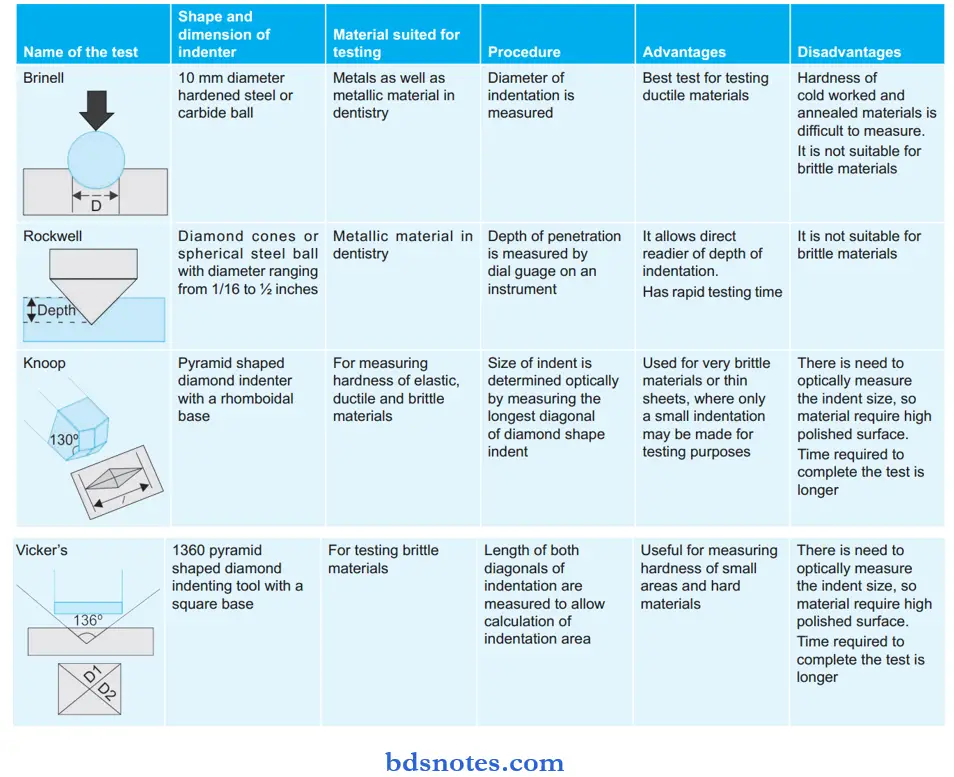
Question 6. Write a short note on creep and flow.
Or
Write a short note on creep.
Or
Write the short answers on creep and flow.
Answer:
1. Creep:
Time-dependent plastic deformation or change of shape that occurs when a metal is subjected to a constant load near its melting point is known as creep.
This may be static or dynamic in nature:
- Static creep: It is a time-dependent deformation produced in a completely set solid subjected to constant stress.
- Dynamic creep: Produced when the applied stress is fluctuating
Importance of Creep:
Dental amalgam has components with melting points that are slightly above room temperature and the creep produced can be very destructive to the restoration. A creep of dental amalgam is a slow progressive permanent deformation of a set amalgam that occurs under constant stress (static creep) or intermittent stress (dynamic creep).
2. Flow:
It is somewhat similar to creep. In dentistry, the term flow is used instead of creep to describe the rheology of amorphous substances, for example, Waxes. Although creep and flow may be measured under any type of stress, compression is usually employed for the testing of dental materials.
Question 7. Write a short note on flexibility and resilience.
Answer:
Flexibility:
- Generally in dental practice, the material used as a restoration should withstand high stresses and show
- minimum deformation. However, there are instances where a large strain is needed with moderate or slight stress.
- For example, in an orthodontic appliance, a spring is often bent a large distance with a small stress. In such a case material is said to be “flexible”.
- The “minimum flexibility” is designed as the strain that occurs when the material is stressed to its proportional limit.
Resilience:
- The term ‘resilience’ is associated with “springiness.” Resilience can be designed as the amount of energy absorbed by a structure when it is stressed not to exceed its proportional limit.
- For example, when an acrobat falls on a trapeze net, the energy of his fall is absorbed by the resilience of the net, and when this energy is released. The acrobat is again thrown into the air.
- The resilience of a material is usually measured in terms of its modulus of resilience which is the amount of energy stored in a body, when one unit volume of a material is stressed to its proportional limit.
- Resilience is also measured by the area under the straight line portion of the stress-strain curve.
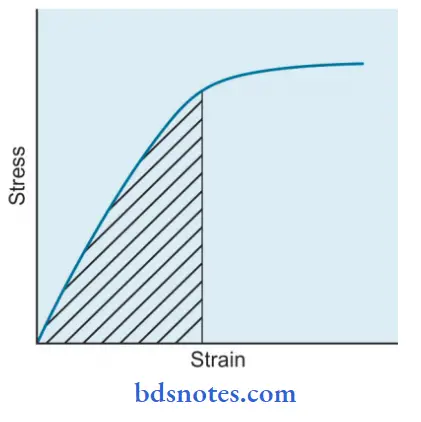
Question 8. Write a short note on the passivation of metals.
Answer:
Passivation of metals:
- Certain metals readily form strong adherent oxide films on their surface which protect them from corrosion.
- Such metal is said to be passive.
- Chromium, titanium, and aluminum are examples of such metals.
- If more than 12 % chromium is added to iron or cobalt, we get stainless steel or cobalt-chromium alloys which are lightly corrosion-resistant and therefore suitable for dental use.
- Since this film is passive to oxidative chemical attack, the formation of such an oxide layer is called passivation.
- The degree is passivity is influenced by a number of factors such as alloy composition, stress in the appliance, and the environment in which it is placed.
Question 9. Write a short note on adhesion and cohesion.
Answer:
1. Adhesion:
Adhesion is defined as a “state in which two surfaces are held together by interfacial forces which may consist of valence forces or interlocking forces or both “American Society for Testing and Materials”.
Concept of Adhesion in Dentistry:
Retention and stabilization of restoration require the removal of sound tooth structure at the time of restorative procedures, but in adhesive restorations, the destruction of intact enamel and dentin is not necessary since retention is mainly adhesive and does not depend on mechanical retentive forces. This results in a tight tooth–a restorative interface that prevents microleakage.
Criteria for Adhesion:
For proper adhesion, interacting surfaces must be attached to each other at their interface regardless of their phases. Factors governing the ability of the adhesive to make intimate contact with the substrate are:
- Characteristics of the substrate.
- Wettability of the substrate by an adhesive
- Viscosity of adhesive
- Morphology or surface roughness of the substrate.
Clinical Applications of Adhesion:
The common aspects of clinical dentistry where the principles of adhesion are applicable are as follows:
- Adhesion of bacterial plaque biofilm to the enamel.
- Chemical, mechanical, and micromechanical retention of restorative materials to the tooth structure.
- Mechanical and micromechanical adhesion of fixed partial dentures.
- Retention of orthodontic brackets onto the enamel surface
- Retention of posts in endodontically treated teeth.
- Adhesion between the impression tray and the elastomeric
impression material with the help of tray adhesives.
Factors Affecting Adhesion:
Following are the factors which affect adhesion with the tooth structure, i.e…
- Composition: Enamel and dentin consist of both organic and inorganic components at different proportions. A material that adheres to the inorganic component may not adhere to organic components making adhesion
difficult. - Smear layer: As the tooth is prepared for receiving any restoration, the smear layer formed as a result of cutting interferes with proper wetting and also reduces the surface energy of the substrate, whether it is enamel, dentin, or
cementum resulting in poor adhesion. - Saliva: Another problem associated with bonding is the contamination of the cut surface by saliva and other oral fluids. Since inorganic components of the tooth structure have a greater affinity for these flids, adequate isolation is essential for optimal bonding.
- Water: Dentinal tubules consist of water which will compete with the adhesive liquid to flow and fill the crevices. Etched enamel and dentin have a greater affinity for water; this poses a problem when hydrophobic bonding agents are used prior to composite resin restorations.
2. Cohesion:
Cohesion is the force of molecular attraction between molecules or atoms of the same species, for example, Water molecules. As per the Glossary of Prosthodontic Terminology (GPT) cohesion is the molecular attraction by which the particles of the body are united throughout their mass.
This is based on the principles of dipole attraction due to the uneven distribution of electrons around the atoms or the molecules. It happens when two, unlike molecules or substances, join together on being brought in contact because of the force of attraction between them, for example, the Cohesion of salivary molecules interposed between denture and tissue surface.
Application of Cohesion in Dentistry: Pure gold either in foil or other form is cohesive and can be welded to itself at the mouth or room temperature simply by the application of force.
Question 10. Write a short note on tensile strength and compressive strength
Answer:
Tensile Strength:
It is determined by subjecting a rod, wire, or dumbbell-shaped specimen to a tensile loading. Tensile strength is defined, as the maximal stress the structure will withstand before rupture. Due to tensile loading, there is an alteration in the dimension of the material along the long axis of force before the material undergoes rupture or fracture. This length alteration is called as elongation.
- Tensile strength is determined by the equation of load and cross-sectional area (Kgf/cm2).
Compressive Strength:
Compressive strength or crushing strength is determined by subjecting a cylindrical specimen to a compressive load. The strength value is obtained from the cross-section area and force applied. Though the load is compressive, the failure is due to complex stresses. Common materials tested for compressive strength are restorative materials such as amalgam and cement, and auxiliary materials, i.e. investments, and impression materials.
- Compressive strength is determined by load divided by cross-sectional area, i.e. Kgf/cm2.
Question 11. Write a short note on Hardness.
Answer:
- Hardness is defined as resistance to permanent indentation.
- Initially, an arbitrary hardness indexing scheme known as the Mohs scale is used to determine hardness.
- It does not have any clinical relevance, though the measurement of hardness is an indicator of other properties.
- Hardness values are used as an indicator of various other properties, i.e.
-
- Resistance to wear: The hardness of the restorative material plays a major role in its resistance to wear, though hardness cannot be taken as an absolute indicator of wear resistance. Softer substances essentially do not wear faster than harder substances.
- Strength: Some materials such as gypsum display a relationship between hardness and strength.
- Degree of polymerization: At times, hardness values are used to indicate the degree of monomer conversion in denture-based resins and resin composites; it is implied that higher hardness values indicate a greater
degree of polymerization. - Depth of cure of resins: The depth of cure of light-activated composite resins can also be evaluated using hardness tests. A known thickness of composite resin specimen is light-cured. The surface hardness is evaluated on the cured surface and the bottom surface. If the surface is completely polymerized, it can be expected that the bottom surface be at least 80% as
hard as the top surface.
Question 12. Write in detail the biocompatibility of the material.
Or
Write briefly on biocompatibility
Or
Write briefly on the biocompatibility of dental materials.
Or
Write a short note on biocompatibility.
Answer:
Biocompatibility is defined as the ability of restorative material to induce an appropriate and advantageous host response during the intended clinical usage. Murray et al. 2007
Anatomical and Pathological Aspect of Oral Tissues:
- Enamel—because of the high mineral content, enamel is much more brittle than dentin and is solubilized to a great extent by acid solutions.
- This property is used to advantage with bonding agents, where acids are used to etch the enamel to provide micromechanical retention of resin composite materials.
Biocompatibility of Dental Materials:
Microleakage: There is evidence that restorative materials may need to bond to enamel or dentin with sufficient strength to resist the forces of contraction on polymerization, wear, or thermal cycling.
- If a bond does not form or debonding occurs, bacteria, food debris, or saliva may be drawn into the gap between the restoration and the tooth by capillary action.
- This effect has been termed microleakage.
- Microleakage plays a significant role in pulpal irritation, but that the materials can also alter normal pulpal and dentinal repair.
- Restoration materials may directly affect pulpal tissues or may play an auxiliary role by causing sublethal changes in pulpal cells that make them more susceptible to bacteria or neutrophils.
Dentin Bonding:
Because the dentinal tubules and their resident odontoblasts are extensions of the pulp, bonding to dentin also involves biocompatibility tissues.
- When the dentin surface is cut, such as in cavity preparation, the surface that remains is covered by a layer of organic and inorganic debris called a smear layer.
- This smear layer is also deposited into the dentinal tubules to form dentinal plugs.
- The presence of the smear layer is important to the strength of bonds of restorative materials and the biocompatibility of those bonded materials.
- From the standpoint of biocompatibility, the removal of the smear layer may pose a threat to the pulpal tissues for three reasons:
- Increase the risk that materials can diffuse and cause pulpal irritation.
- Make any microleakage more significant because a significant barrier to the diffusion of bacteria or bacterial product towards the pulp is removed.
- Acids are used to remove the smear layer and are a potential source of irritation themselves.
Dentin Bonding agents:
A variety of dentin bonding agents have been developed and are applied to cut dentin during the restoration of the tooth.
- Many of these reagents are catatonic to cells.
- When placed on dentin and rinsed with tap water between applications of subsequent reagents as prescribed.
- Hydroxyethylmethacrylate (HEMA), a hydrophilic resin contained in several bonding systems is at least 100 times less catatonic in tissue culture than Bis-GMA.
- Resin-based materials: Freshly set chemically cured and light-cured resins afterward cause moderate cytotoxic reactions.
The cytotoxicity is significantly reduced 24 to 48 hours after setting. With a protective liner or a bonding agent, the reaction of the pulp to resin composite materials is minimal.
Amalgam and Casting Alloys:
The biocompatibility of amalgam is throughout determined largely by corrosion products released from the restoration. Free or unreacted mercury from amalgam is toxic. Low-copper amalgams are well tolerated, but high-copper amalgams cause severe reactions when in direct contact with tissues.
- Cast alloys: These alloys contain several other noble and non-noble metals that may hurt cells if they are released from the alloys.
However, released metals are most likely to contact gingival and mucosal tissues. - Glass ionomers: Freshly prepared ionomers are mildly cytotoxic but this effect is reduced with increased times after settling. In usage tests the pulp reaction to glass ionomer cements is mild.
Question 13. Write a short note on Young’s modulus.
Or
Write a brief note on the modulus of elasticity.
Or
Write a short note on the modulus of elasticity.
Answer:
It is also referred to as ‘elastic modulus’ or ‘Young’s modulus’.
- It represents the relative stiffness or rigidity of the material within the elastic range.
- Young’s modulus is the ratio of stress to strain. Since stress is proportional to strain, the stress-to-strain ratio would be constant.
- Modulus of elasticity or Young’s modulus strain
- E = Stress/Strain = s/e
- It therefore follows that the less the strain for a given stress, the greater will be the stiffness, for example, If a wire is difficult to bend, considerable stress must be placed before a notable strain or deformation results.
- Such a material would possess a comparatively high modulus of elasticity.
- The unit of Young’s modulus is psi (pounds per square inch).
Clinical Application of Young’s Modulus of Elasticity:
An example of a clinical situation can be given with an illustration of the impression materials.
- Impression material should have a low modulus of elasticity to enable it to be removed from the undercut areas in the mouth.
- But at the same time, the modulus should not be so low that the material cannot withstand tearing.
- In restorative materials, generally, the modulus has to be high, i.e. the materials have to be stiff enough to withstand the forces of mastication.
- A material with a lower modulus is used to restore class V lesions since the material has to possess better flexural strength to withstand the flexural stresses acting in the cervical area.
Question 14. Write short notes on Hue, Value, and Chroma.
Or
Write long answers on Hue, Value, and Chroma.
Answer:
To accurately describe a beam of light reflected from the surface of a tooth or restoration, three variables should be measured, i.e. Hue, Value, and Chroma.
Hue:
- Hue describes the dominant color of an object, e.g. red, green, yellow, or blue.
- It represents the dominant wavelength present in the spectral distribution. Red, green, and blue are the primary hues, while yellow, cyan, and magenta form the secondary hues.
- The primary hues are the colors that cannot be made by mixing other colors; hence, they are called primary colors. Secondary colors can be made by mixing two primary colors, e.g. mixing red and blue gives violet.
Value:
- Objects of the same color can be separated into lighter or darker shades.
- Value can be defined as the lightness or darkness of a color.
- Value also referred to as the grayscale value can be measured independently of the hue.
- It is independent of the color.
- White color appears less white as the light intensity decreases. Hence it is said that the value of color decreases as it becomes darker.
Chroma:
- The degree of saturation of the hue is known as chroma.
- Chroma is a measurement of color intensity. For example, the yellow color of a lemon is less saturated than that of a sunflower.
Question 15. Write a short note on color.
Answer:
Color can be defined as a complex psychological phenomenon resulting from the behavior of light through its wavelength to the human eye.
- Color is the effect of light waves striking the retina of the eye.
- It is produced by the reflection, absorption, or transmission of light.
- It is what is seen apart from size, shape, and texture.
- An object by itself does not have color. It has only the ability to reflect or transmit light from the various parts of the spectrum and this reflected or transmitted light is seen as the color of an object.
- Therefore, “no light, no color.”
- They are always in the same order; violet which has the shortest wavelength is at one end of the spectrum and red which has the longest wavelength is at the opposite end. By recombining these waves, the color of the source is reproduced.
- Metamerism is the change in color matching of two objects under different light sources.
- Perception of the color of an object is entirely a subjective experience, a result of a physiological response to physical stimulus.
- There are three dimensions of color, i.e. hue, value, and chroma.
- Hue describes the dominant color of an object.
- Value can be defined as the lightness or darkness of a color.
- The degree of saturation of the hue is known as chroma.
- For measuring the color there are several methods, i.e. Munsell system, RGB system, etc. Munsell system is used commonly as the parameters of color are represented in three dimensions. This system measures color quantitatively.
Question 16. Write a short note on the space lattice.
Answer:
There are 14 different combinations of cell structure and atomic arrangement. These combinations are called space lattices.
- A space lattice is a regular, 3-dimensional arrangement of atoms in a space in a crystalline material.
- Several solid-state reactions can occur in a solid substance and it is due to the diffusion of atoms, for example, In Gold-copper alloys, gold, and copper atoms may be distributed randomly in the space lattices leading to disordered lattices.
- This disordered pattern may change to an ordered pattern in which gold atoms occupy the center of the cubic type of space lattice and copper atoms occupy the corner positions in the space lattice.
- This happens due to the movement or diffusion of atoms under the influence of controlled heat treatment.
- In practical terms, this will change the physical properties of hardness, brittleness, strength, and conductivity of a material.
- Casting gold alloys are heat-treated for this very purpose.
Question 17. Write a short note on yield strength and its significance.
Answer:
Yield strength is defined as the stress at which a material exhibits a specified limiting deviation from the proportionality of stress to strain.
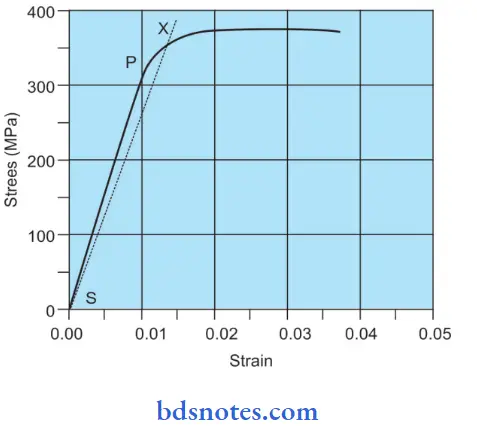
- Yield strength is determined by selecting the desired offset (S) and drawing a line parallel to the linear region of the stress-strain curve. The point on the stress-strain curve where the offset meets is the yield strength (Point X).
- Offet is the arbitrary value put for the material.
- Yield strength is expressed in MPa.
Significance of yield strength: Yield strength determines the percent of total permanent deformation which is acceptable for the material. In dentistry, 0.1% and 0.2% offer are most commonly used.
Question 18. Write a short note on BHN and KHN.
Answer:
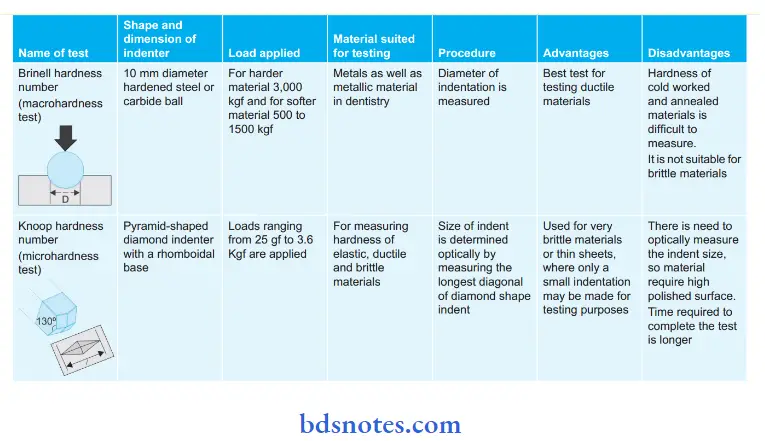
Question 19. Describe briefly hardness.
Or
Write a short note on hardness.
Answer:
Hardness is defined as resistance to permanent indentation. Initially, an arbitrary hardness indexing scheme known as the Mohs scale is used to determine hardness. Hardness does not have any clinical relevance, though the measurement of hardness is an indicator of other properties.
Hardness values are used as an indicator of various other properties, i.e.
- Resistance to wear: The hardness of the restorative material plays a major role in its resistance to wear, though hardness cannot be taken as an absolute indicator of wear resistance. Softer substances essentially do not wear faster than harder substances
- Strength: Some materials such as gypsum display a relationship between hardness and strength
- Degree of polymerization: At times, hardness values are used to indicate the degree of monomer conversion in denture-based resins and resin composites; it is implied that higher hardness values indicate a greater degree of polymerization.
- Depth of cure of resins: The depth of cure of light-activated composite resins can also be evaluated using hardness tests. A known thickness of composite resin specimen is light-cured. The surface hardness is evaluated on the cured surface and the bottom surface. If the surface is completely polymerized, it can be expected that the bottom surface be at least 80% as hard as the top surface.
Question 20. Write a short note on the KHN number.
Answer:
KHN number stands for Knoop hardness number. The Knoop hardness value is independent of the ductility of the tested material.
Following are the various Knoop hardness numbers of some selected materials:
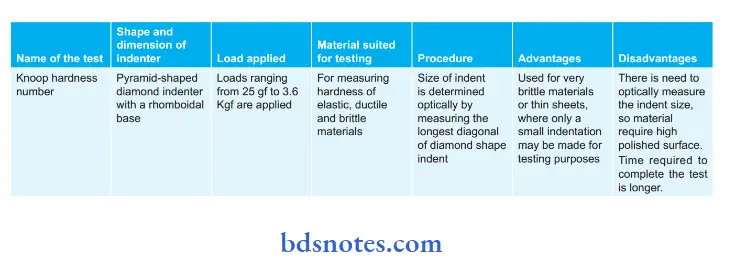
KHN is a microhardness test:
The knoop hardness value is independent of the ductility of the tested material. Following are the various Knoop hardness numbers of some selected materials
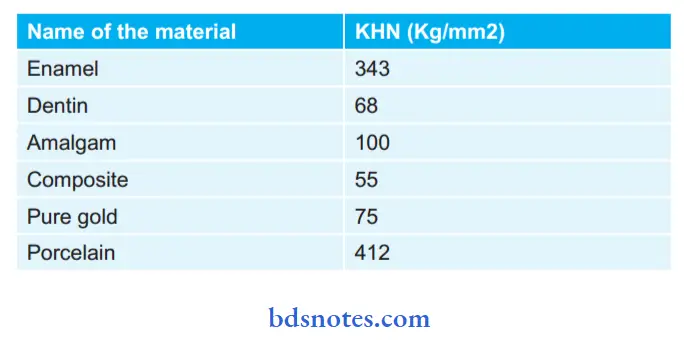
Question 21. Write a short note on color perception.
Answer:
Perception of the color of an object is entirely a subjective experience, a result of a physiological response to physical stimulus. Color perception is described by three objectives of variables, i.e. hue, value, and chroma.
Hue of color perception:
- Hue describes the dominant color of an object, for example, Red, Green, Yellow, or Blue.
- It represents the dominant wavelength present in the spectral distribution.
- Red, green, and blue are the primary hues, while yellow, cyan, and magenta form the secondary hues.
- The primary hues are the colors that cannot be made by mixing other colors; hence, they are called primary colors. Secondary colors can be made by mixing two primary colors, for example, Mixing red and blue gives violet.
Value of color perception:
- Objects of the same color can be separated into lighter or darker shades.
- Value can be defined as the lightness or darkness of a color.
It is also referred to as the grayscale value that can be measured independently of the hue. - It is independent of the color.
- White color appears less white as the light intensity decreases. Hence it is said that the value of color decreases as it becomes darker.
Chroma of color perception:
- The degree of saturation of the hue is known as chroma.
- Chroma is a measurement of color intensity.
- For example, The yellow color of a lemon is less saturated than that of a sunflower.
Factors Influencing Color Perception:
Various factors interfere with the true perception of color, i.e. individual parameters such as fatigue of the eye due to repeated viewing of colors, low or high light levels, sex, and age; the surface of an object being viewed, and surrounding conditions.
- Repeated Viewing of Color Perception: Seeing the tooth for more than 5 seconds at a time should be avoided since this results in our eyes becoming accommodated to the red and yellow colors.
- Age and Sex of Color Perception: Our ability to perceive color and visual acuity is also affected by aging, chronic illnesses, glaucoma, and medications such as oral contraceptives, analgesics, antiepileptic drugs, and aspirin.
Surroundings of Color Perception:
- The perception of color is affected by interference from surrounding colors.
- Dark and bright clothing, lipstick, makeup, etc., will affect the selection of color and shade of teeth.
- Hence, patients should be instructed to wear light and neutral color clothing and avoid heavy makeup and dark lipsticks.
- When a patient is viewed in a room with intense colored walls, there is a tendency to select a hue that is complementary to the background color.
- Hence shade selection should be always performed in a room with neutral colors, preferably gray.
- At low light levels, the rods of the human eye are more dominant than the cones, and color perception is lost.
- At the same time, when the light is too bright, the color appears to change. This phenomenon is known as the Bezold-Brucke effect.

Leave a Reply